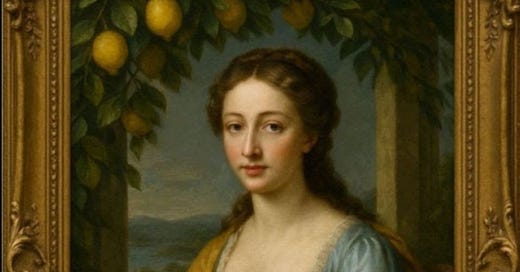PREVIOUSLY: A Paris debut, a tech bro denied, and a suspicious pigment resembling one from an 18th century Habsburg painting…
Continental School, 18th Century, Portrait of Archduchess Maria-Louise with Lemons
From: 11th Arrondissement Authentication Department
To: [REDACTED]
Subject: Analysis of Pigment “Lemonium Deceptus”
Date: May 15, 2025
Objective
To evaluate the yellow pigment present in the sample submitted by Mademoiselle Penelope Thorne and determine its historical validity—specifically in relation to “Continental School, 18th Century, Portrait of Archduchess Maria-Louise with Lemons.”
Methodology
Pigment Analysis: Micro-sampling & Raman spectroscopy.
Comparative Reference: 18th-century Austrian pigment archives.
Provenance Review: Cross-check with Schloss Schwarzenberg pigment records (1887).
Findings
Pigment Identified: Lemonium Deceptus
First synthesized in 1887 during a chemical mishap at the Schloss Schwarzenberg pigment factory. Originally dismissed for its unnatural citrus brilliance, the pigment nevertheless found its way into a number of questionable works.
Visual Profile:
An unnatural hue: equal parts citrus, scandal, and suspicion. Somewhere between tax haven teal, alimony pink, and lemon left too long on a yacht.
Historical Footprint:
Long considered too “vulgar” for serious portraiture by scholars and conservators, Lemonium Deceptus has reappeared in several paintings later exposed as forgeries or suspicious reattributions.
Comparative Result:
The pigment found matches Lemonium Deceptus exactly. The same pigment is also present in the Portrait of Archduchess Maria-Louise with Lemons, previously flagged for chromatic inconsistency. No trace of this pigment exists in legitimate 18th-century palettes.
Habsburg Anachronism:
In a further twist, the signature on the painting contains pigment elements not commercially available until 1954. This further distances the work from any plausible 18th-century attribution, confirming its modern creation.
Conclusion
This painting is not from the 18th century. Its creation post-dates 1887, likely emerging in the late 19th or early 20th century. It bears hallmarks of modern fabrication, both chemically and stylistically.
Recommendation
Attribution: Reassign as a post-1887 work.
Sale Status: Must not be marketed or sold as 18th-century.
Provenance: Requires urgent revision and disclosure.
Attachments
(1) Brothelby’s Auction Catalogue - Flagged: Lot 43
(2) Falsified Certificate of Authenticity – Dated: 17 FEB 2025
Sincèrement,
Michel Duchamp
Head of Authentication
11th Arrondissement, PARIS






